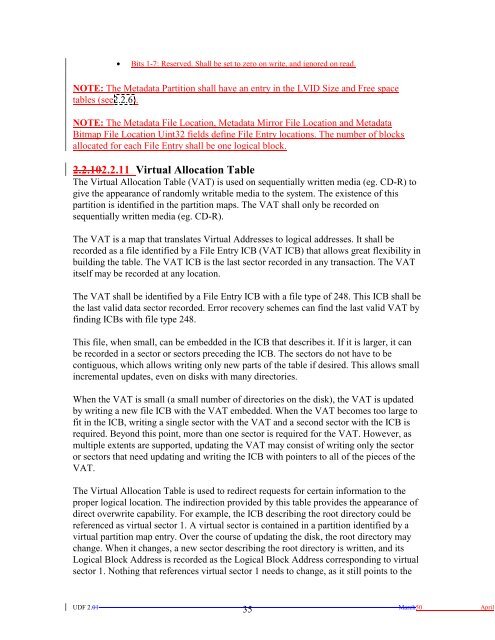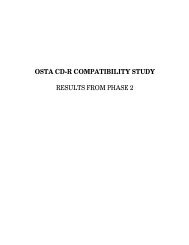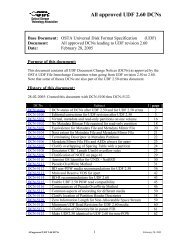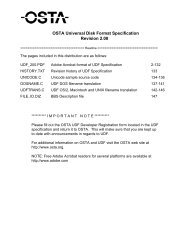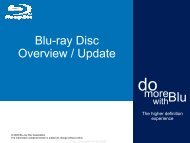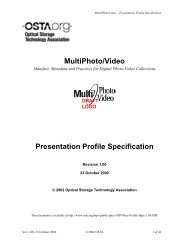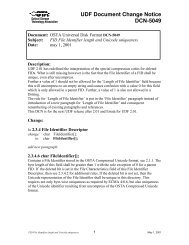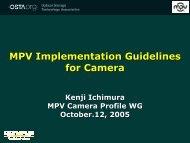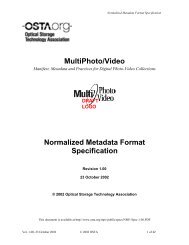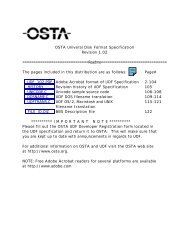here - OSTA - Optical Storage Technology Association
here - OSTA - Optical Storage Technology Association
here - OSTA - Optical Storage Technology Association
Create successful ePaper yourself
Turn your PDF publications into a flip-book with our unique Google optimized e-Paper software.
• Bits 1-7: Reserved. Shall be set to zero on write, and ignored on read.<br />
NOTE: The Metadata Partition shall have an entry in the LVID Size and Free space<br />
tables (see2.2.6).<br />
NOTE: The Metadata File Location, Metadata Mirror File Location and Metadata<br />
Bitmap File Location Uint32 fields define File Entry locations. The number of blocks<br />
allocated for each File Entry shall be one logical block.<br />
2.2.102.2.11 Virtual Allocation Table<br />
The Virtual Allocation Table (VAT) is used on sequentially written media (eg. CD-R) to<br />
give the appearance of randomly writable media to the system. The existence of this<br />
partition is identified in the partition maps. The VAT shall only be recorded on<br />
sequentially written media (eg. CD-R).<br />
The VAT is a map that translates Virtual Addresses to logical addresses. It shall be<br />
recorded as a file identified by a File Entry ICB (VAT ICB) that allows great flexibility in<br />
building the table. The VAT ICB is the last sector recorded in any transaction. The VAT<br />
itself may be recorded at any location.<br />
The VAT shall be identified by a File Entry ICB with a file type of 248. This ICB shall be<br />
the last valid data sector recorded. Error recovery schemes can find the last valid VAT by<br />
finding ICBs with file type 248.<br />
This file, when small, can be embedded in the ICB that describes it. If it is larger, it can<br />
be recorded in a sector or sectors preceding the ICB. The sectors do not have to be<br />
contiguous, which allows writing only new parts of the table if desired. This allows small<br />
incremental updates, even on disks with many directories.<br />
When the VAT is small (a small number of directories on the disk), the VAT is updated<br />
by writing a new file ICB with the VAT embedded. When the VAT becomes too large to<br />
fit in the ICB, writing a single sector with the VAT and a second sector with the ICB is<br />
required. Beyond this point, more than one sector is required for the VAT. However, as<br />
multiple extents are supported, updating the VAT may consist of writing only the sector<br />
or sectors that need updating and writing the ICB with pointers to all of the pieces of the<br />
VAT.<br />
The Virtual Allocation Table is used to redirect requests for certain information to the<br />
proper logical location. The indirection provided by this table provides the appearance of<br />
direct overwrite capability. For example, the ICB describing the root directory could be<br />
referenced as virtual sector 1. A virtual sector is contained in a partition identified by a<br />
virtual partition map entry. Over the course of updating the disk, the root directory may<br />
change. When it changes, a new sector describing the root directory is written, and its<br />
Logical Block Address is recorded as the Logical Block Address corresponding to virtual<br />
sector 1. Nothing that references virtual sector 1 needs to change, as it still points to the<br />
UDF 2.01<br />
35<br />
March50 April


